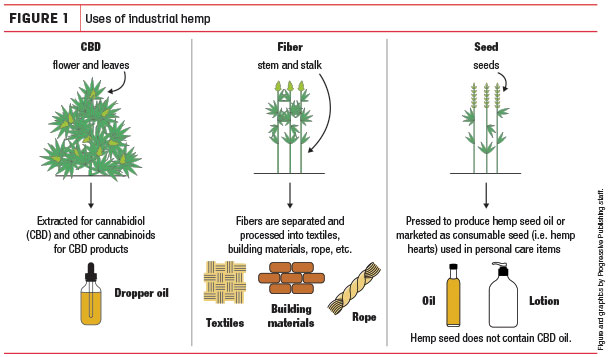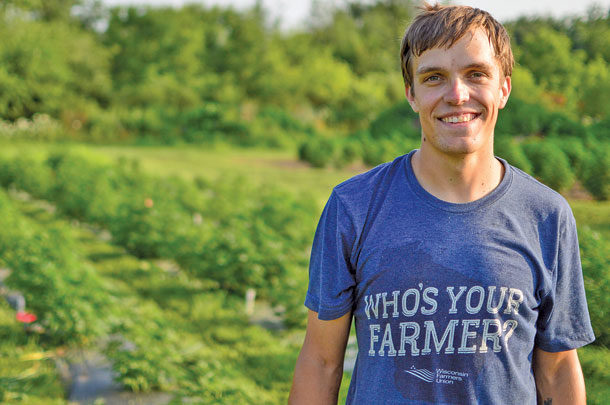You have decided to grow hemp. Now what?
In today’s rapidly changing world of hemp, the first step is to find a market, says Dylan Bruce, a research specialist with the University of Wisconsin – Madison’s Organic and Sustainable Agriculture Research and Extension program in the Plant Pathology department.
The three most common end products that come from hemp are fiber, grain and CBD (cannabidiol) oil.
There is not yet much infrastructure in the U.S. for processing hemp fiber, which is used in a variety of products including rope, textiles, paper, bioplastics, insulation and biofuel. There are consumer interest and existing markets supplied by other production regions, says Bruce, but the system for processing fiber is not common here – yet.
Hemp grown for grain is used primarily for human consumption. Hemp seed is considered highly nutritious and can be eaten raw, roasted or cooked with other foods.
Hemp grown for CBD oil is currently the most common type grown in the U.S. The oil is commonly used to reduce chronic pain, insomnia and anxiety, although the only FDA-approved use is for epilepsy treatment via the drug Epidiolex. The CBD oil market has boomed in the last few years, but that doesn’t mean a guaranteed profit if you plant it.
The cultivation of hemp dates back about 8,500 years, and it came to North America in approximately 1600, says Leah Sandler, who worked with the Michael Fields Agricultural Institute studying hemp until recently. Cannabis was made illegal in 1937. Hemp production for fiber was revived for a short time during WWII and then was illegal again.
In 1970, cannabis was declared a controlled substance, Sandler says. The 2014 Farm Bill separated the definition of industrial hemp from that of marijuana, based on the level of tetrahydrocannabinol (THC). This allowed states to launch pilot research programs and, finally, the 2018 Farm Bill (yet to be fully implemented in most states) removed hemp from the controlled substance list and lifted the restrictions on its cultivation.
Both marijuana and hemp come from the same plant, Cannabis sativa. All hemp legally grown in the U.S. is required to have less than 0.3% of the naturally occurring compound THC, the level at which a psychoactive effect does not occur. Marijuana is considered to have levels of THC that far exceed that limit. According to the National Library of Medicine, average THC found in recreational marijuana is 17%.
Bruce says before planting hemp, the first step is to find out what type of markets exist in your region. Contact potential buyers and processors to see if they need product and, if so, what type of product they would buy. If you come to an agreement, get a written contract, Bruce says, and then have your lawyer look over the agreement before you sign it.
“Everything is changing very quickly,” Bruce says. “There could be more infrastructure popping up very soon.”

Just as with other crops, seed is specifically geared toward a desired end product, whether that be hemp for fiber, grain or CBD. Generally, fiber cultivars are extremely tall, thin and harvested at an immature stage when fewer cannabinoids are present, Bruce says. Cultivars bred for the production of CBD are usually stockier and more heavily branched. Varieties for seed often fall somewhere in between.
If you already have a farm and you have choices in your region as to what type of hemp you should grow, Bruce says there are many variables to consider, including equipment and labor. For example, hemp for CBD production can have a higher return per acre but requires significantly more labor. A farm that currently grows vegetables or has orchards may be better suited to CBD production, while a farm with existing row crops might be better suited to grain or fiber.
Bruce says the differences between growing hemp for CBD oil extraction compared to fiber and grain are analogous to growing different market classes of corn. Growing for fiber or grain may be similar to planting field corn for livestock feed or for human consumption; you look at the best seed for the use, and you care for your fields similarly. Growing for CBD is more like sweet corn in that not only is the seed a different variety, caring for it is very different.
In the Upper Midwest, hemp for any use is usually planted fairly late, around June 1, because it requires relatively warm soil temperatures, but this varies from region to region.
When calculating how to fit hemp into your crop rotation, Bruce says it is important to be cognizant of the later planting date and expected maturity, which varies on market classes and day length.
There are many options for cover crops that can be used with hemp. “White clover is most common in-season, but there are lots of options for fall and spring cover,” he says.
Hemp has a robust root system, and the roots generally put carbohydrates into the soil, which feeds the “good” microorganisms and may improve soil health.
Currently, it is illegal to feed any hemp products to cattle or use it as bedding, even on your own farm. Research from other countries is showing the byproducts that remain after processing hemp seed can make a good cattle feed due to the high protein content. Bruce says producers who want to use the products or byproducts with cattle should contact their lawmakers or their state’s department of agriculture to urge a change in regulations to allow it.
Approach growing hemp with caution, Bruce says, and don’t invest more acres than you can afford to lose an income on. Knowing what other farms in your area might be growing hemp is important as well; cross-pollination from hemp fields being grown for a different purpose – even miles away – may interfere with your outcome.
Bruce says there are recommendations and systems being developed in many different regions of the country on how to best grow hemp for each specific purpose. A good place to find out more is your local university extension office.
Bruce organized the 2019 Wisconsin CBD Hemp Field Day, attended by over 350 people, manages an ongoing CBD hemp fertilizer trial, and manages small-scale CBD hemp biomass and seed production on his home farm.
Bruce and Sandler were among the speakers talking about hemp production at the 2020 MOSES organic farming conference held annually in Wisconsin.






